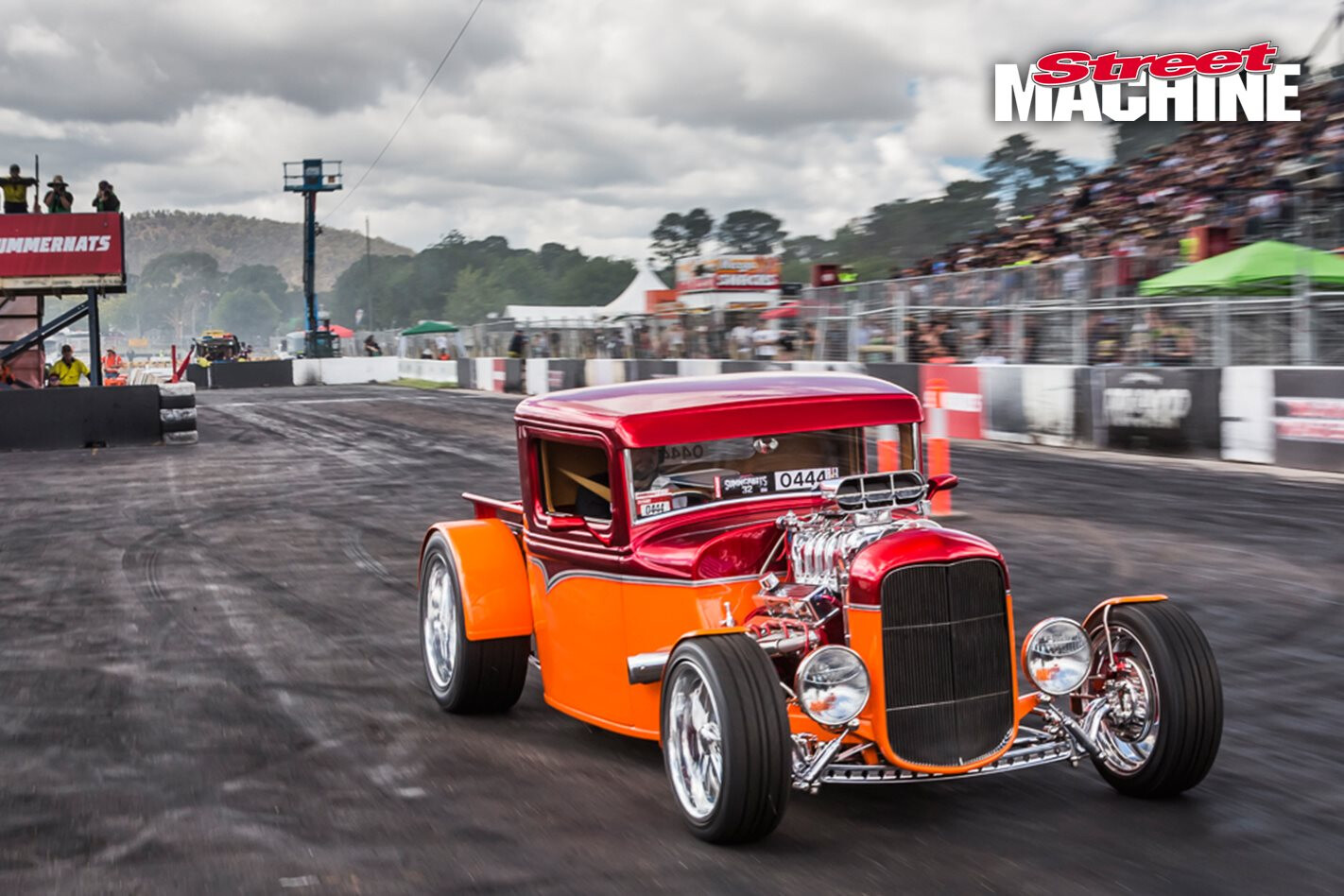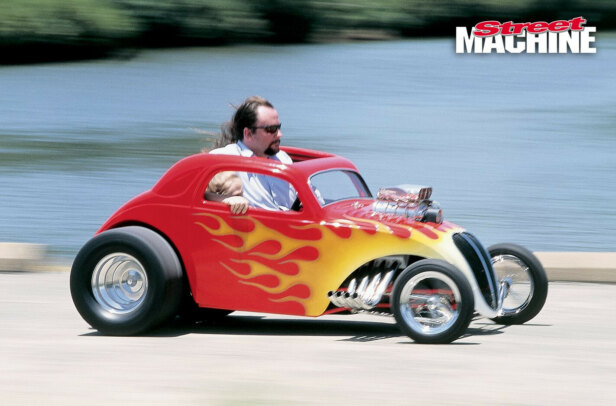THE day I ring Rick Werner to have a chat about his ’32 pick-up, he’s just about to leave his job of 38 years at Norco Milk. “I started off here as an apprentice fitter and turner and then just worked my way up to engineering manager,” he explains. “I’ve got seven months’ long service leave up, so I’m just going to have a break for a bit and get back into doing some hands-on stuff.”
This article was first published in Street Machine Hot Rod magazine #20, 2019
Rick’s intention was always to build a Hot Wheels car that a person could fit in comfortably. With its wild proportions and brightly coloured paint, he’s nailed the brief
That lifetime of working with his hands – machining, fabricating and welding – has been a massive advantage when it comes to building feature-worthy cars. This will be the third car of his we’ve featured – fourth if you count the Morris 1100 that Rick built as his first car, resplendent with Mercedes-Benz headlights and XB Falcon tail-lights.
“I think it ended up in the back of a Street Machine as a joke,” he says. “I just had those parts and wanted to know how to panel-beat, so my brother-in-law showed me how. I saw Pat Fay’s hearse and thought it looked so cool, so I got a set and put them in the 1100. I wouldn’t recommend it; it was the ugliest-looking thing. It had an International Scout grille in it and an Escort panel van spoiler on the roof, flared guards.” In other words, all the good stuff!
Thankfully, Rick’s tastes improved, as did his car-building skills, and he moved from metal to fibreglass as he developed a taste for Corvettes. We featured his Lime Gold ’65 in SM, Nov ’01 after spotting it in the Top 60 hall at Summernats, and then had his ’32 Ford five-window coupe on the cover of SM Hot Rod 2008. His latest creation, this Hot Wheels-inspired ’32 closed-cab pick-up, really showcases Rick’s talents as a hot rod builder. Apart from borrowing a booth to paint the car himself and getting Rides By Kam to help out with some of the trickier parts of the interior trimming, Rick did the whole thing at home in the shed. If you don’t believe me, check out the build photos.
Starting off with a handful of floppy fibreglass body panels, Rick had to create all of the inner framework to hold the body together. He then mounted it on a chassis fabricated from laser-cut pieces TIG-welded together and using rectangular tubing for the crossmembers to allow as much clearance as possible underneath. Rick wanted a heavily channelled look to the pick-up, but still wanted a reasonable amount of room in the cab, so the chassis steps down in the middle to allow that.
Rick spent a lot of time getting the proportions just right, but he also had to consider the legalities of getting the car registered in Queensland.
It’s not all about the show with Rick’s pick-up. There’s a 383 Chev topped by a 6/71 Hampton blower to make sure there’s plenty of go as well
“I sat down and drew it all to scale on an A1 sheet of paper,” he says. “The main thing I had to look for was the distance from the top of the scoop to the sump plug; I had to make sure the sump plug was four inches off the ground and the top of the scoop allowed me to still see 11 metres. That’s how I had to design it, otherwise I would have channelled it more.” Even with those compromises, Rick still ended up with a pretty radically proportioned hot rod.
Part of that radical look is due to the pie-cut roof chop, where Rick took five inches out of the front and four inches from the rear of the cab, but that wasn’t the only custom bodywork performed on the pick-up.
“The hardest thing was recessing the doors, because ’32 commercial vehicles are like a Model A door and they overlap the body front and back,” Rick explains. “I also removed the swage line from the door and continued that on the body more like a coupe. There’s not much of the mould that is original; it’s all been cut-and-shut and moved.”
The tip-up tray, which works via two electric linear actuators, is very handy when you’ve got a load of mulch for the garden or if you need to check the oil level in the diff. It also reveals all of the clever fabrication and detailing that Rick performed on the chassis
More mastery of the glass fibres was performed on the interior, where just about everything has been custom-formed from foam, shaped and then laid up. “The dash is all made from block foam – three- or four-inch-thick surfboard foam – then that was all hand-carved.” That’s a fairly oversimplified explanation, because if you look at the dash, Rick has split it with the top half painted and the bottom trimmed. There’s a door that can be removed to access the master cylinder, and there is a custom-made chrome trim that runs across the middle.
The bed has been lined in jarrah, a West Aussie hardwood, and a recess made for the fuel filler!
The best bit, though, is the little door that hides the stereo head unit. Like all good hot rodders, Rick used whichever parts would do the job: “The bottom panel swings up; it’s got eccentric cams in there with off-road radio-controlled car shocks on it, so it’s got soft-close and soft-open. You lift it up about 25mm and the door continues to go up, same when you close it.”
The diff is a full-floater 9in from Schreiner Enterprises. It’s held in place with a So-Cal Speed Shop triangulated four-bar and Aldan coil-over shocks handle the bumps
Every other part of the interior was also fabricated or modified by Rick. The Prelude seats got cut-and-shut to suit the confines of the pick-up cab, and several more cans of expanding foam were put to good use creating the centre and roof consoles. Rick even fabricated his own inner door handles.
“I made them to flow with the line of the armrests inside and the graphics on the outside, which reflects back to the 50s Customline trim,” he says.
The ball-milled brake covers double as caliper mounts and were machined by Rick himself. They are used on the front as well
With all of the fabrication done, you’d think it would be time to ship the car off to someone for final prep and paint. But nope, that’s not how Rick rolls. He did borrow a booth off a mate to lay down the Spray Chief Candy Red over HOK Tangelo Pearl two-tone paintjob, even masking and airbrushing the ‘chrome’ trim that separates the two colours. To make it even more challenging, Rick didn’t paint the whole lot in one go, which could have led to total disaster.
The interior is completely custom-built from fibreglass panels moulded over carved foam. The design was developed by Rick’s daughter, Danielle. They are used on the front as well
“I did the cab and doors over a period of about four days, and the tray was done four weeks later,” he explains. “I had to take photos and measurements, write down all the fluid nozzle settings and pressures, how many times I walked around it, all that stuff. I had to make sure where I airbrushed the trim it all lined up, because it wasn’t painted on the chassis; it was all done on chassis jigs. I could have painted the whole thing and been out 10mm and it wouldn’t have looked real good.”
The dash was custom-made from carved foam and then fibreglassed. It houses a trio of Shark gauges, and the stereo is hidden behind a slide-away panel. The roof console and moulded hoodlining feature more of Rick’s handiwork in fibreglass. The console has storage pockets and vents that feed fresh air from above the windscreen. Clever!
Everything turned out just fine, with the little pick-up taking home a swag of awards every time it’s been shown, including the big one: Summernats 32 Grand Champion. But even that didn’t come easy: “I got Top 10 at Summernats 31 and Top 3 for the Grand Champ. For Summernats 32 I detailed it a bit better, but mainly tuned it up and learnt to drive it a bit better.” Rick put over 7000km on the clock between the events, which was a big part of why the car went so well in the driving events.
All of the painted sections that run across the door tops and between the seat were shaped in foam, then painted and trimmed
It was a popular win, and with the blown 383 Chev uncorked for the ceremony, the car sounded as good as it looked. I wonder what the creative mind and talented hands of Rick Werner will come up with next? “I’ve got too much stuff to do at home, I’ve been told!” he laughs.
RICK & JULIA WERNER
1932 CLOSED-CAB PICK-UP
Paint: HOK Tangelo/Spray Chief Candy Red
ENGINE
Type: 383ci Chev
Inlet: Hampton
Carb: Holley 850 DP
Blower: Hampton 6/71
Heads: Edelbrock E-Street
Valves: 2.02in (in), 1.60in (ex)
Cam: Lunati
Pistons: Probe forged
Crank: Scat stroker
Conrods: Chevy X
Radiator: Hot Spot Radiators
Exhaust: Lakes headers, twin 2.5in stainless pipes
Ignition: Pertronix Flame-Thrower
SHIFT
’Box: Turbo 700R4
Converter: Red Diamond 2600rpm stall
Diff: Schreiner fully floating 9in, Strange 3.89 centre, Truetrac
BENEATH
Front end: So-Cal Speed Shop drilled and chromed 4in dropped I-beam
Rear end: So-Cal Speed Shop triangulated four-bar
Shocks: So-Cal Speed Shop (f), Aldan coil-overs (r)
Steering: Vega box
Brakes: Wilwood 11in discs (f), Schreiner 11in discs (r)
ROLLING STOCK
Rims: Intro Aurora; 17×7 (f), 20×10 (r)
Rubber: Achilles 205/45/17 (f), Nexen 295/45/20 (r)
THANKS
Andrew Reid at Rapid Fab; Harts Automotive Paint Supplies Southport; Phil Woodbridge; Kevin McDermott; Rides By Kam; Rod Brewer; Phil Ford; Gold Coast Electroplating; Peter Elliot at Hot Spot Radiators; Jay Shaw; Precise Engine Rebuilders; Ron at ARC; Dave at Auto One Ashmore; Competition Coatings; Peter Leahy; Chad and Nicole Lackey; my wife Julia; my daughter Danielle for her artistic guidance with the interior and build




Comments